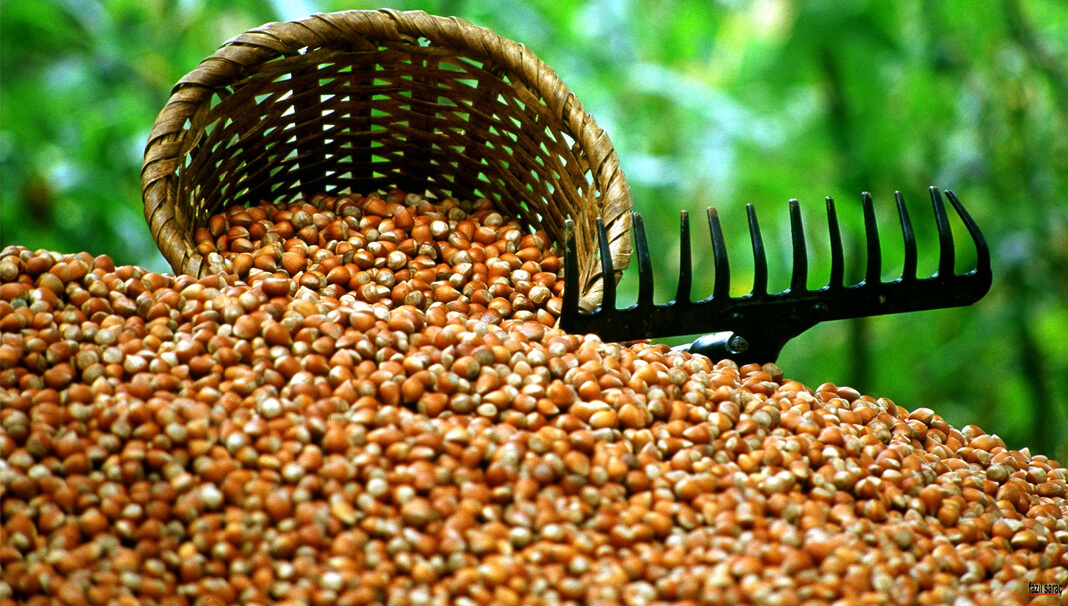Hazelnut in Turkey
Historical documents state that hazelnuts were produced on the Black Sea coast in northern Turkey 2300 years ago, and that hazelnuts have been exported from Turkey to other countries for the last six centuries. Turkey, one of the few countries in the world with appropriate weather conditions for hazelnut production, accounts for 75% of total global production and 70-75 percent of exports.
Hazelnut gardens, which are high in number along Turkey’s Black Sea coasts, are spread over an area of no more than 30 kilometers from the coast to the interior. They stretch eastward across the entire Black Sea, beginning from Zonguldak (east of Istanbul) in the Western Black Sea and ending at the almost as far Georgian border, like a green belt between the sea and the mountains.
In Turkey, 4,000,000 people are directly and indirectly involved in the production of hazelnuts on 550-600 thousand hectares, increasing the socioeconomic importance of hazelnuts. Due to its superior quality, Turkey holds a distinguished position among the world’s hazelnut-producing countries, and it sustains to dominate the market as a leader both in production and export.
PRODUCTION AREAS
The hazelnut tree, which grows on the earth at 36-41 northern latitudes and in its own unique climatic conditions, gives a yield in areas where the altitude does not exceed 750-1000 meters and are 30 kilometers inland from the coasts.
Turkey’s hazelnut growing regions are divided into two sub-regions:
a) 1st Standard Region (eastern part of the Black Sea Region): Provinces of Ordu, Giresun, Rize, Trabzon and Artvin.
b) 2nd Standard Region (central and western part of the Black Sea Region): Provinces of Samsun, Sinop, Kastamonu, Bolu, Düzce, Sakarya, Zonguldak and Kocaeli.
Harvest
Turkish hazelnuts typically mature between the beginning and end of August, depending on the height of the garden. Shaking off the hazelnut branches and collecting the husked hazelnuts that fall to the ground provides harvesting on time. Another method is to collect them one by one from the branches.
Depending on the quality of the soil, the hazelnuts collected from the gardens are transported to the threshing floor the same day or a few days later, to be laid on the floor, (the thickness of the hazelnut pile reaches up to 10-15 cm), and left to dry under the sun until their husks become brown. This process is called pre-drying. After the withering process, the hazelnuts are removed from the husks using a threshing machine and dried in thin layers on the tents under the sun.
Depending on the weather, the total drying period, including pre-drying, takes 15-20 days. Drying organically and under the sun is an essential factor in the tastefulness of Turkish hazelnuts.
Area of Usage
Almost 90% of the hazelnuts consumed as snacks in Turkey and around the world are also used as an auxiliary component in roasted, in the form of blanched, chopped, sliced, flour and pureed in chocolate, biscuits, confectionery sectors, dessert, cake, and ice cream making, dinners, and salads.
Hazelnut, which has been around for about 5,000 years, provides numerous benefits to humanity, from its fruit to its wood. In our country, particularly in hazelnut-producing regions, hazelnut shell is used as a valuable and high-calorie fuel.
Furthermore, hazelnut wood can be utilized to make baskets, walking sticks, chairs, fences, and hand tools. Some species are grown in parks and gardens as ornamental plants. Using hazelnut leaves and fruit husks fertilizer can also be produced. Surplus hazelnuts can be evaluated as oil. Hazelnut oil is refined and assessed as edible oil, and hazelnut pulp is used as an additive in the feed industry.
INDUSTRY AND TRADE
In our country, there are currently 180 crushing plants with an annual internal capacity of 1,800,000 tons and 40 processing plants with an internal capacity of 350,000 tons. While shell and natural kernel hazelnuts accounted for 90% of our hazelnut exports in the 1970s, the percentage of processed hazelnut exports in total exports surpassed 30% in 2000 as a consequence of positive and rapid advances in the hazelnut processing sector.
Thanks to the effective and careful quality control mechanisms applied in every stage of the production, the export of specially processed hazelnut kernels grows year after year in tandem as a response to the demand of the buyer company’s expectations. The processed hazelnuts produced in our country are of much superior quality than the processed hazelnuts prepared in their own facilities by many importers and industrialists by obtaining natural hazelnuts.
